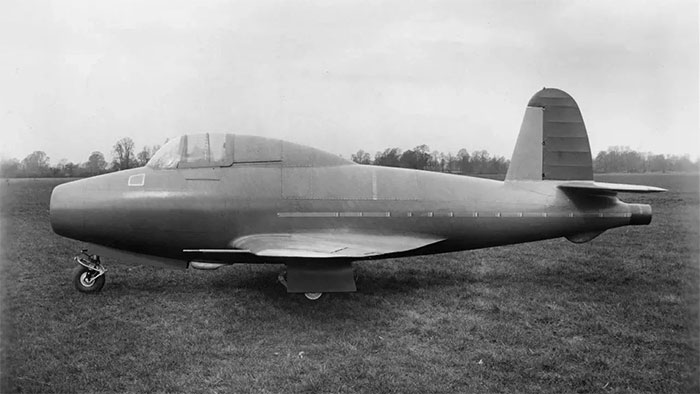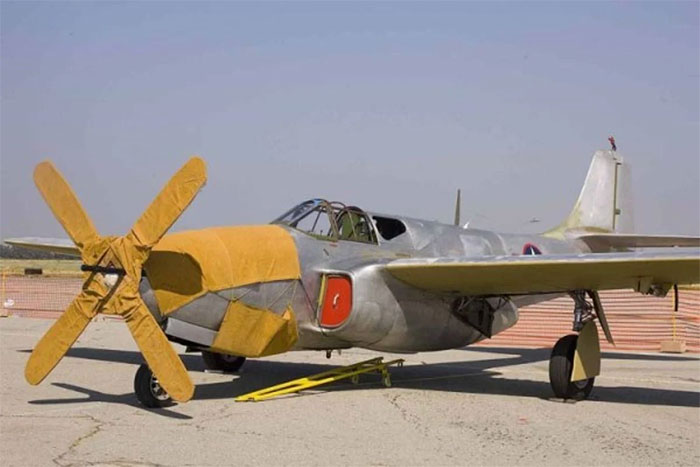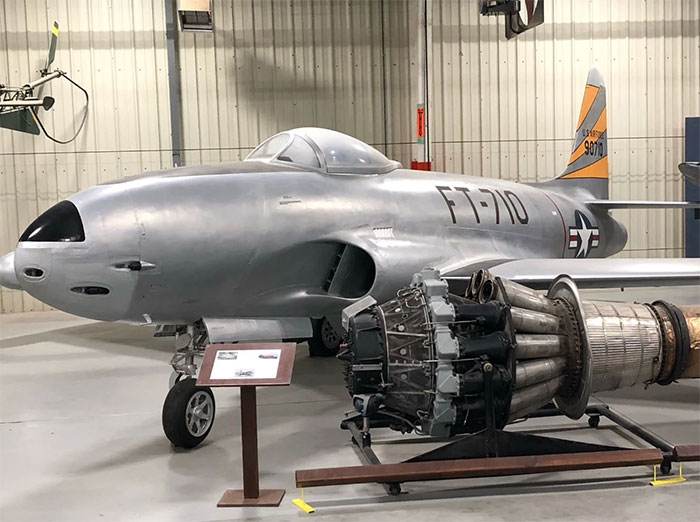Eighty-year history of American jet fighters
Over the past 80 years, air forces around the world have used five generations of jet fighters. What all five generations have in common is the jet engine, an invention so revolutionary that the United States did not build any more fighter jets with propellers after the technology was introduced.
Jet engines have greatly improved the capabilities of fighter aircraft. It allows them to break the sound barrier, carry large quantities of bombs previously only carried by large bombers, and fly near the edge of space. This article will review the five generations of jet fighters that have been used to date and the upcoming generation: the sixth generation fighter.
First Generation (1942): Comets and Meteors
In 1941, the Allies' first jet-powered aircraft, the British Gloster E.28/39, was secretly demonstrated before US Army and Air Force officials. These officials then asked American industry to build their own jet fighters. As part of this urgent project, Bell Aircraft created the P-59 Airacomet (Comet), which was the first jet aircraft in America. Airacomet's development is kept secret. Bell even covered the fuselage with canvas to hide the large air intakes, a feature unique to jets, and added a fake propeller to the front that acted as a camouflage tool. This aircraft made its first flight in October 1942 but it was never used in combat.

Prototype of the Gloster E.28/29 in April 1941. (Photo: Baesystems).

To maintain secrecy, the P-59 Airacomet was camouflaged with a wooden propeller. (Photo: Aviation History).
Born not long after the Airacomet was the Lockheed P-80 Shooting Star. The P-80 was also created in a short period of time, with development beginning in 1943 and first flight taking place in 1944. The Shooting Star was the first aircraft to fly faster than 500 mph (804 km). /hour) in a straight line, eventually reaching speeds of up to 580 mph (933 km/h). It was designed as a high-altitude interceptor, using jet engines to fly higher than propeller aircraft and then attack propeller aircraft from above. The P-80 flew only a few reconnaissance missions in Europe before the end of World War II in Europe, but it was used extensively during the Korean War. The P-80 is only equipped with guns, specifically six .50 BMG (0.5 inch) caliber machine guns in the nose.

Lockheed P-80 Shooting Star fighter next to its engine. (Photo: Facebook).
Second generation (1958): The period of combining Jet Engines and Rockets
The North American F-86 Saber was not the first jet fighter produced by the United States, but it was the first equipped with air-to-air missiles. This combination is still very strong today. The F-86 Saber fighter is very successful, with nearly 10,000 aircraft built and used by 30 countries around the world, including the US Air Force and Navy. The F-86 is considered a second-generation fighter, appearing just a few years after wartime jets such as the Me262 and Meteor.

An F-86A Saber preserved at Kemble Air Day 2008, UK. (Photo: Wikipedia).
In 1958, the Portuguese Air Force (FAP) received 50 F-86Fs from the old inventory of the US Air Force (USAF). Several former Norwegian Air Force F-86Fs were also purchased as spares during 1968–9. FAP deployed some of its F-86F Sabers to Portuguese Guinea (ie Guinea-Bissau, now a small country in West Africa) in 1961 and were stationed at Bissalanca Air Base, Bissau. These aircraft were used during the Guinea-Bissau War of Independence, in ground attack operations and in close support against rebel forces. In August 1962, F-86F code 5314 skidded off the runway during an emergency landing with bombs still attached to hardpoints under the wings and burned. Another F-86F was shot down by enemy ground fire on May 31, 1963, but the pilot ejected safely and was rescued. Several other aircraft were damaged in combat but were repaired.
In 1964, 16 F-86Fs based in Bissalanca returned to mainland Portugal due to pressure from the United States. They performed 577 combat missions, including 430 ground attack and close support missions.

An F-86F of the Portuguese Air Force. Until the 6th generation of fighters was about to be born, these F-86s still flew very well. (Photo: imodeler).
Third generation (1961): The jet engine was perfected
The F-4 Phantom was a significant advance in US military aviation from 1961 to 1996. It was equipped with a J-79 turbojet engine, which was much more powerful than a radial piston engine. ), this allowed the F-4 to fly faster and carry more bombs than World War II bombers. The F-4 is a versatile and versatile aircraft, so it can be used for many different types of missions, including air superiority, strike action, close support, reconnaissance and suppression. air room. It is classified as a third generation fighter.

Luftwaffe F-4Fs in flight on January 21, 1998. (Photo: Wikipedia).
The F-4 Phantom was introduced just 16 years after the end of World War II, and by that time the history of the fighter had already entered its third generation. It could reach a top speed of 1,711 mph (2753 km/h), four times faster than the famous P-51D Mustang, and it could fly up to an altitude of 18,200 meters, more than twice as high. Although it is less than half the weight of the B-29 Superfortress heavy bomber, it can carry 50% more weapons, with a total load of 8,164 kg including bombs, missiles and sensor compartments. All of this was managed by a crew of just two people, nine fewer than the crew needed for the B-29 bomber.
Hellenic Air Force RF-4E Phantom II socks
 Hellenic Air Force RF-4E Phantom II with special color scheme, landing at RIAT 2008, UK. (Photo: Wikipedia).
Hellenic Air Force RF-4E Phantom II with special color scheme, landing at RIAT 2008, UK. (Photo: Wikipedia).
1964: Swing-wing fighter
During the Cold War, one of the most exciting advances in aviation was the "spread wing" or variable-shaped wing. As the wings are tilted forward, they have a smaller sweep angle, this configuration improves the stability and control of the aircraft at lower speeds. It is especially useful during takeoffs, landings and maneuvers, which require slow speeds. On the other hand, when the wings are tilted backwards (with a larger sweep angle), the aircraft will be more suitable for flying at high speeds. This is because the swept-back wings reduce drag, helping the plane fly faster. This configuration is often used during high-speed pursuits or when the aircraft is flying at cruising altitude. The swing-wing design allows engineers to create a plane that can do both, which they do by mounting the wings on hinges so they can tilt forward or backward while flying. fly.

Four different positions of the F-111 Aavark fighter wing. (Photo: Tinhte).
The first American aircraft with a 'spread-wing' design was the F-111 'Aardvark'. This is a fighter bomber mainly used for bombing at low altitudes. The second aircraft with this design was the famous F-14 Tomcat. It will take off and land with its wings facing forward, but when it needs to intercept an enemy aircraft, it will retract its wings backwards. Over time, the spread-wing design became less popular because it was heavy and mechanically complex. Any moving part in a machine has a higher risk of damage than fixed components. The spreader was eventually replaced by a computer-aided control system.

An F-14D Tomcat was on a mission over the Persian Gulf in 2005. Its shape has many similarities to the F-111 Aardvark except for the vertically stabilized tail and rear rudder. (Photo: Wikipedia).
1971: Vertical takeoff and landing
In 1971, the US Marine Corps received the world's first fighter jet that could take off and land vertically. The AV-8A Harrier, manufactured by the British company Hawker Siddeley. It is powered by a Rolls-Royce Pegasus engine that can direct thrust in any direction, whether horizontal, vertical or any intermediate direction between horizontal and vertical. This means this aircraft is unique as it does not need to use an airport runway for takeoff or landing. It can operate from US Navy ships that can be deployed both on land and on water, and it is very versatile in air combat.

A TAV-8A Harrier fighter of the United States Marine Corps. (Photo: Wikipedia).
The AV-8A Harrier was later replaced by a more advanced fighter model, the AV-8B Harrier II. The Marines were so interested in the idea of fighter jets that could take off vertically or on short runways that they requested a special version of the F-35 Lightning II, known as the F-35B, have similar features.

The Italian Air Force's AV-8B Harrier II fighter is hovering. (Photo: Wikipedia).

The US Marine Corps' AV-8B Harrier II takes off vertically from the USS Bataan, 2023. (Photo: Pop Mech).
The Fourth Generation (1978): A generation that will not pass away
American fighter planes actually suffered a lot of damage during the Cold War. America's wartime experience saw large, sluggish third-generation jets ineffective in visual air battles in the 1970s. This led to the birth of of fighters such as the F-16 Fighting Falcon, introduced in 1978. The F-16 combines a high thrust-to-weight (by acceleration/gravitational acceleration) ratio with exceptional maneuverability to create creating an aerial warrior that few opponents can match.

An F-16 Fighting Falcon at Osan Air Base, South Korea. (Photo: Osan).
Fourth generation aircraft remain useful for a much longer period of time than previous generations thanks to several updates. These enhancements include precision-guided weapons controlled by guidance/targeting equipment, upgraded radar, and new upgraded air-to-air missiles such as the AIM-9L Sidewinder and AIM-120 AMRAAM. Today, 45 years after the first F-16A entered service, the aircraft is still in production. In fact, new F-16Vs are currently being produced in the state of South Carolina.

F-16V fighter, the latest variant of the F-16, in the hangar. (Photo: Lockheed Martin).
1983: Stealth fighter
Four decades ago, the idea of a plane that could avoid radar detection was just a dream. Significant aircraft losses in the past lead to the question: is it possible to build an aircraft that cannot be detected by radar? In theory, an aircraft specially designed to reduce radar reflection and painted with radar-absorbing paint could sneak past enemy defenses undetected. If this aircraft is equipped with laser-guided bombs, it can not only bomb the target accurately, but also have a high chance of survival.

An F-117A is on display. (Photo: Sac Museum).
In 1983, while people were dreaming about a stealth 'fighter', one was actually put into operation in secret. The F-117A Nighthawk, developed, built and flown in complete secrecy, was at that time being used at the Tonopah Proving Ground in Nevada. Ultimately, 59 of these aircraft were built. They first saw combat in the war in Panama in 1989. The F-117A was also used in Operation Desert Storm in 1991, the UN intervention in Yugoslavia in 1999, the Afghanistan campaign in 2001 and including the 2003 Iraq war.

The F-117A is the first fighter designed to use stealth on an operational basis. (Photo: Pop Mech).
Fifth generation (2005): Raptor fighter and friends
In the late 1980s, a program called the Advanced Technology Fighter (ATF) was initiated with the goal of creating a new fighter to replace the F-15 Eagle. This new aircraft will be the first fighter designed for air-to-air combat with stealth from the start. It will have a Pratt & Whitney F119 engine so powerful that the plane can fly faster than the speed of sound. It will also have a radar system using active electronically scanned array technology, which can detect enemy targets from very far away. Development of the aircraft slowed as the Cold War ended, but it finally entered service in 2005 as the F-22 Raptor.

F-22 Raptor test flight with Pratt & Whitney F119 engine operating at full capacity in afterburner mode, Edwards Air Force Base, California. (Photo: Wikipedia).
The F-22 is the first fighter of the fifth generation and its features set the standard for this generation. After the F-22, other aircraft such as China's 'Mighty Dragon' Chengdu J-20, Sukhoi Su-57 and America's F-35 Lightning II were also developed. These aircraft all have similar features to the F-22. A total of only 195 F-22s were produced.

F-22 with external weapons pylons. (Photo: Wikipedia).

F-35C fighter on the deck of the USS Lincoln. (Photo: Breakingdefense).
Sixth Generation (2020)
The F-22 and F-35 fighter jets were created during relatively peaceful times, which is why it took each of them more than 10 years to go from concept to finished product. Since Russia and China have both built their own fifth-generation fighters, the US Air Force and Navy have begun researching the first sixth-generation fighters. Both branches of the military are designing their own warplanes, both calling their designs the Next Generation Air Dominance (NGAD).

Lockheed Martin's 6th generation NGAD fighter concept. (Photo: Sanboxx).
In September 2020, the US Air Force announced that it had built, tested and flown a prototype of a new fighter, also named NGAD. Even three years later, people still don't know what it looks like or what it can do. It's still too early to say for sure, but it's likely that sixth-generation fighters will have features such as radar that can be reconfigured for different purposes, and pilotless combat drones. It can operate as a robotic airlifter, and its engines can adapt to prioritize speed or fuel efficiency.

Another idea from Lockheed Martin about a sixth generation fighter. (Photo: Pop Mech).
- Top 8 most formidable air-to-air combat fighters in the world: Which name is at number 1?
- F-35 fighter - The most expensive weapon program in American history
- Video: The beauty history of American men in the past century
- Japan buys a new fighter jet
- The UAV model promises to change the military nature of the US military
- Learn the dominant power of Su-35 fighter
- 99 years of American tank history in a GIF
- The photo is the highest possible award at Wildlife Photographer of the Year 2017
- 4 military tactics have 1-0-2 in history only genius thought out
- Cinnamon cat entered the history of science
- The dark history of the dam in the top 7 greatest works in American history: The price to pay is very expensive
- History of dogs and American civilization
 Biography of hero Vu A Dinh
Biography of hero Vu A Dinh History of hematology
History of hematology Who is Mr. Tam Da 'Phuc-Loc-Tho' and what does it mean?
Who is Mr. Tam Da 'Phuc-Loc-Tho' and what does it mean? Unbelievable facts about the history of the oil and gas industry: Gasoline used to be cheaper than water, so abundant that it had to be dumped into the river...
Unbelievable facts about the history of the oil and gas industry: Gasoline used to be cheaper than water, so abundant that it had to be dumped into the river...